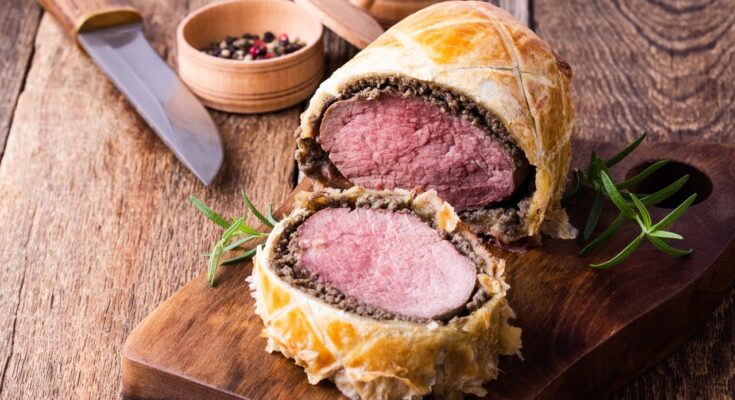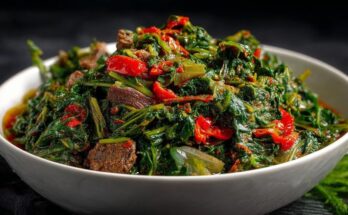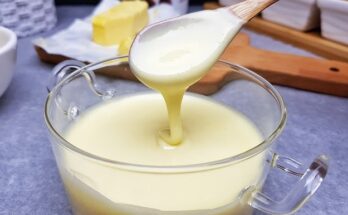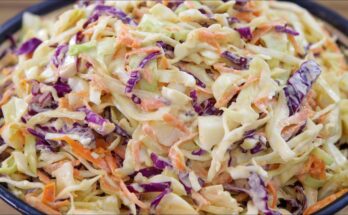Beef Wellington Recipe: Beef Wellington is a classic, gourmet dish that combines tender beef fillet, savory mushroom filling, prosciutto, and a flaky puff pastry crust. Making it at home can seem daunting, but this step-by-step guide will walk you through every detail to prepare an unforgettable meal.
What is Beef Wellington?
Beef Wellington is a traditional British dish celebrated for its luxurious blend of textures and flavors. The recipe wraps a perfectly seared beef tenderloin in a layer of earthy duxelles (a finely chopped mushroom mixture) and prosciutto, all encased in golden, buttery puff pastry. It’s a meal often reserved for holidays and special occasions because of its rich, elegant flavor and beautiful presentation.
Why Make Beef Wellington at Home?
Cooking Beef Wellington at home allows you to enjoy this gourmet dish with fresh ingredients tailored to your taste. While it requires time and patience, homemade Beef Wellington offers satisfaction and control over ingredients, portion sizes, and quality. You can create a customized version with premium or unique ingredients, making it a memorable dining experience.
Ingredients Needed
Main Ingredients for Beef Wellington
- Beef Tenderloin (Filet Mignon) – 1 to 2 lbs., center-cut for uniform shape.
- Puff Pastry – Store-bought or homemade, enough to wrap around the beef.
- Mushrooms – A mix of button, cremini, or wild mushrooms for rich flavor.
- Prosciutto – Thinly sliced to add savory depth and prevent sogginess.
- Dijon Mustard – For coating the beef after searing, adding sharpness.
Specialty Ingredients
- Truffle Oil or Truffle Paste (optional) – Adds a hint of earthiness.
- Foie Gras (optional) – A rich, luxurious addition inside the pastry.
Including these specialty ingredients can elevate your Beef Wellington by adding deeper, more complex flavors.
Seasonings and Garnishes
- Salt and Pepper – Essential for seasoning at different stages.
- Fresh Thyme and Rosemary – Herbaceous notes complement the mushrooms.
- Egg Yolk – For brushing on the puff pastry to achieve a golden finish.
Preparation Steps
Step 1: Prepping the Beef Tenderloin
- Seasoning and Searing: Generously season the tenderloin with salt and pepper. Heat oil in a skillet over medium-high heat. Sear the beef on all sides, around 2-3 minutes per side, until browned.
- Coating with Dijon Mustard: After searing, remove the tenderloin from the skillet and let it rest for a few minutes. Coat it evenly with Dijon mustard, adding a tangy layer.
Step 2: Preparing the Duxelles (Mushroom Filling)
- Chop Mushrooms Finely: Using a food processor, pulse mushrooms until finely chopped.
- Cooking the Duxelles: In a skillet over medium heat, cook the mushrooms with butter, shallots, garlic, and fresh herbs (like thyme) until the mixture is browned and moisture has evaporated, around 10-15 minutes. Season with salt and pepper, then set aside to cool.
Step 3: Wrapping in Prosciutto
- Layering: Lay out a layer of prosciutto slices on a piece of plastic wrap, slightly overlapping them to form a sheet.
- Adding the Mushroom Mixture: Spread the cooled duxelles mixture evenly over the prosciutto.
- Wrapping: Place the mustard-coated tenderloin on top, and carefully wrap the prosciutto around it, using the plastic wrap to shape it tightly. Refrigerate for about 15-20 minutes to set.
Step 4: Wrapping the Beef in Puff Pastry
- Preparing the Puff Pastry: Roll out a sheet of puff pastry large enough to wrap the entire tenderloin.
- Placing the Beef: Unwrap the beef from the plastic wrap and place it on the puff pastry.
- Wrapping and Sealing: Carefully wrap the beef in the puff pastry, trimming any excess and sealing the edges with a dab of water. For a decorative look, you can create small pastry cutouts to place on top.
Step 5: Assembling the Beef Wellington
- Sealing: Ensure the pastry is tightly sealed around the beef, and place the seam side down on a baking sheet lined with parchment paper.
- Egg Wash: Brush the pastry with beaten egg yolk to create a golden crust as it bakes. Optionally, score the top lightly for added texture and visual appeal.
Step 6: Baking Time and Temperature
- Preheat the Oven: Set your oven to 400°F (200°C), ensuring it’s fully heated for even cooking.
- Bake the Wellington: Place the prepared Beef Wellington on a baking sheet lined with parchment paper. Bake for approximately 35-40 minutes. For medium-rare beef, aim for an internal temperature of 125-130°F (52-54°C). Adjust the baking time based on your preferred doneness (around 45 minutes for medium).
- Using a Meat Thermometer: Insert a meat thermometer into the thickest part of the Wellington after about 30 minutes of baking. This helps you achieve the desired level of doneness without overcooking.
Step 7: Resting the Beef Wellington
- Importance of Resting: After baking, remove the Wellington from the oven and let it rest for at least 10-15 minutes. Resting allows the juices to redistribute within the meat, preserving the moisture and flavor.
- Avoiding a Soggy Bottom: While resting, place the Wellington on a wire rack if possible. This helps keep the pastry crisp on all sides, ensuring a flaky, golden crust.
Serving and Presentation
Slicing the Beef Wellington
- Using a Sharp Knife: A very sharp, serrated knife is ideal for slicing without crushing the pastry. Start by trimming the ends for a clean presentation.
- Slicing Portions: Cut the Wellington into thick slices, about 1-1.5 inches, to retain the beautiful layers of beef, mushroom filling, and pastry. Serve each slice carefully so that the layers remain intact.
Serving Suggestions and Sides
- Roasted Vegetables: Complement the rich flavors with roasted root vegetables like carrots, parsnips, and Brussels sprouts. The caramelized sweetness balances the savory Wellington.
- Creamy Mashed Potatoes: Soft, buttery mashed potatoes are a classic pairing that adds a comforting texture to the dish.
- Red Wine Reduction or Madeira Sauce: A rich red wine reduction adds depth and acidity to the dish, cutting through the richness of the pastry and beef. Drizzle a small amount over each slice for a gourmet finish.
Tips for a Successful Beef Wellington
- Don’t Rush the Cooling Process: Each layer, particularly the mushroom duxelles and the beef, needs to cool completely before assembling. This prevents the pastry from absorbing excess moisture.
- Choose the Right Pastry: High-quality, all-butter puff pastry is essential. It creates a rich, flaky crust that holds up well during baking.
- Practice Wrapping Techniques: Wrapping the beef tightly with prosciutto and then with puff pastry ensures a neat and compact shape that holds together when slicing.
- Avoid Overcooking: Since the dish continues to cook while resting, it’s best to remove the Wellington from the oven slightly under your target doneness.
FAQs about Beef Wellington Recipe
What is Beef Wellington?
Beef Wellington is a classic dish featuring a tender beef fillet wrapped in layers of pâté, mushroom duxelles, and puff pastry. It’s often served at special occasions due to its rich flavor and impressive presentation.
What cut of meat is best for Beef Wellington?
Traditionally, Beef Wellington uses beef tenderloin or filet mignon, which is a lean, tender cut that cooks evenly and complements the flavors of the pastry and mushroom filling.
Can I prepare Beef Wellington in advance?
Yes, you can assemble Beef Wellington a day in advance. Wrap it in plastic wrap and refrigerate, then bake it just before serving to keep the pastry crispy and the beef perfectly cooked.
How do I prevent a soggy bottom crust?
To avoid a soggy crust, wrap the beef and filling in prosciutto before adding the pastry. Another tip is to chill the Wellington before baking, which helps the pastry bake more evenly.
What should I serve with Beef Wellington?
Beef Wellington pairs well with roasted vegetables, mashed potatoes, or a light salad. A red wine sauce or demi-glace also complements the dish beautifully.
Can I make Beef Wellington with other meats?
Yes, you can substitute beef with other meats like pork or salmon, adjusting the cooking time as needed. However, the flavor and texture will differ from the classic beef version.
How do I know when Beef Wellington is done?
Use a meat thermometer to check for doneness. For medium-rare, the internal temperature should be around 125°F (52°C) before resting, as it will continue cooking outside the oven.
Conclusion
Beef Wellington is more than a meal; it’s a culinary experience. By carefully following each step, from searing the beef to wrapping it with mushroom duxelles, prosciutto, and puff pastry, you’ll create an unforgettable dish. Mastering Beef Wellington at home lets you enjoy this restaurant-quality meal with family and friends, offering both the satisfaction of accomplishment and the joy of a delicious, gourmet dinner.
Enjoy the elegance and flavor of Beef Wellington and consider it a new centerpiece for your most special gatherings.
References
For those seeking more in-depth information and additional tips on preparing Beef Wellington, here are some reputable sources that provide valuable insights and techniques:
- BBC Good Food – Offers expert tips on preparing classic Beef Wellington, including ingredient substitutions and step-by-step instructions.
- Bon Appétit – Known for culinary excellence, Bon Appétit provides a detailed guide on mastering Beef Wellington, from crust to filling.
- Food Network – Includes insights from renowned chefs, providing variations on Beef Wellington and helpful preparation tricks.
- AllRecipes – A community-driven platform offering tested Beef Wellington recipes, along with user reviews and helpful cooking hacks.
These sources ensure you have reliable, varied perspectives for refining your Beef Wellington technique and adding unique twists.



